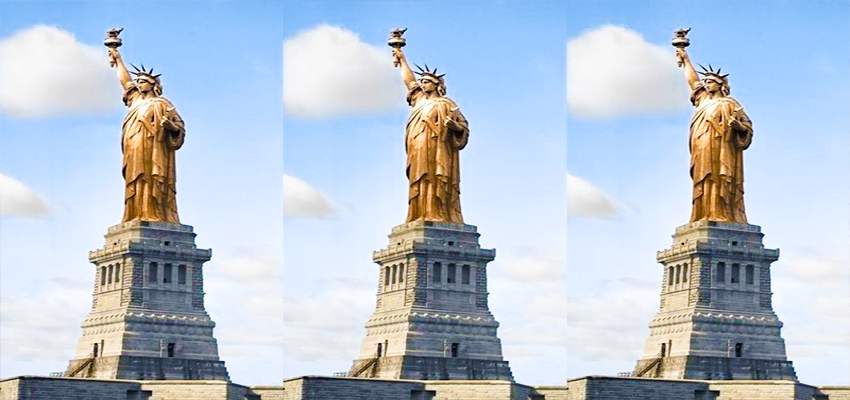The Statue of Liberty, the symbol of freedom and liberty in America and everything that’s great about this country. There she is. Lady Liberty, standing there in all of her blue/green glory, but she wasn’t supposed to be this color.

The Statue of Liberty was a gift from France back in 1885 as a way of commemorating our fight for independence and their own aspirations towards democracy. This 305 foot statue was built over nine years in sections of copper skin on top of an iron skeleton.
According to the National Park Service, the statue has about 30 tons of copper, which is enough to make 435 million pennies. Yes, bright, reddish gold pennies! But the Statue of Liberty isn’t the same color as, well, any penny we’ve ever seen.

So how to explain Lady Liberty’s color change?
Simple. You’d change colors, too, if you stayed outside of the polluted air of New York City for almost 150 years. Well, mostly it all comes down to chemistry.
During her first few decades in the Big Apple, the statue slowly turned from that shiny copper color to a dull brown and then finally to the blue green, or, as they say back in France, verdigres; on screen – [The Green Of Greece] that we see today.

Officials suggested trying to restore her to the original color or painting her. But after a public outcry, they decided to leave her the way she is. And She’ll continue to look like that until Dr. Zaeha shows up.
Anyway, her color change happened because of oxidation reactions between copper and the air. We know some of you smartypants might be saying, well, duh. But copper’s petina is more complicated than just one reaction.
Oxidation Reaction Is The Concerning Cause
It’s due to about 30 years worth of oxidation reactions, creating a mixture of minerals. So let’s get into it. Now, when an atom loses electrons in a chemical reaction, it’s called oxidation. This process was first observed in reactions that involved oxygen, hence the name, but it can happen with other elements too. The color change from coppery red to blue green was bound to happen as soon as they parked in New York Harbor. And here’s why.
First, there’s all the oxygen in our atmosphere just hungry for electrons. Then you add all the elements in New York’s polluted air into the mix, and voila.
In the first reaction, copper gives up electrons to oxygen. That creates this mineral cuprite, which you can see is a pinkish red. Next cuprite loses more electrons to more oxygen forming blackish tenorite. The black color of this tenorite explains why the statue slowly got darker over the years.
Role Of Sulfur Reaction
Now let’s pivot to sulfur reactions. Sulfur finds its way into the atmosphere through natural processes, including volcanic eruptions. But humans have also put a lot of it there, too, with their boats and cars and pesky airplanes and factories. So when sulfur dioxide gets together with water, it forms sulfuric acid, which can form green stuff with copper oxides.
Now back to our color change. Lady Liberty gets painted with the sulfuric acid, and her green color gets forming. Throw in some chloride from the sea spray around the statue’s Ellis Island home, and, well, you see what happens.
Chemistry Background
Here’s the chemistry breakdown: Tenorite that black stuff reacted with sulphuric acid and water to make blue-green Brochantite. And thanks to New Yorkers, there was even more sulphuric acid in the air. So the Brochantite became a green antlerite in some places on the statue.
Whatever the sea spray hit the Statue of Liberty and didn’t get washed away by rain,Brochantite sulfate got swapped for chloride and made olive green Atacamite. So there it is, the beautiful and, well known, bluegreen hue.
The Statue of Liberty has stayed this color for over 100 years because the exposed copper is now oxidized. And she’s stable at this point in her life. At least until she decides to take a walk.
Anyway, the Statue of Liberty wouldn’t be the same if she lived anywhere else. If nothing else, she has a New Yorker’s thick skin and has helped protect her over these years.
So what do you think? Should Lady Liberty say, the blue green color of freedom or return to her glorious brown color?





